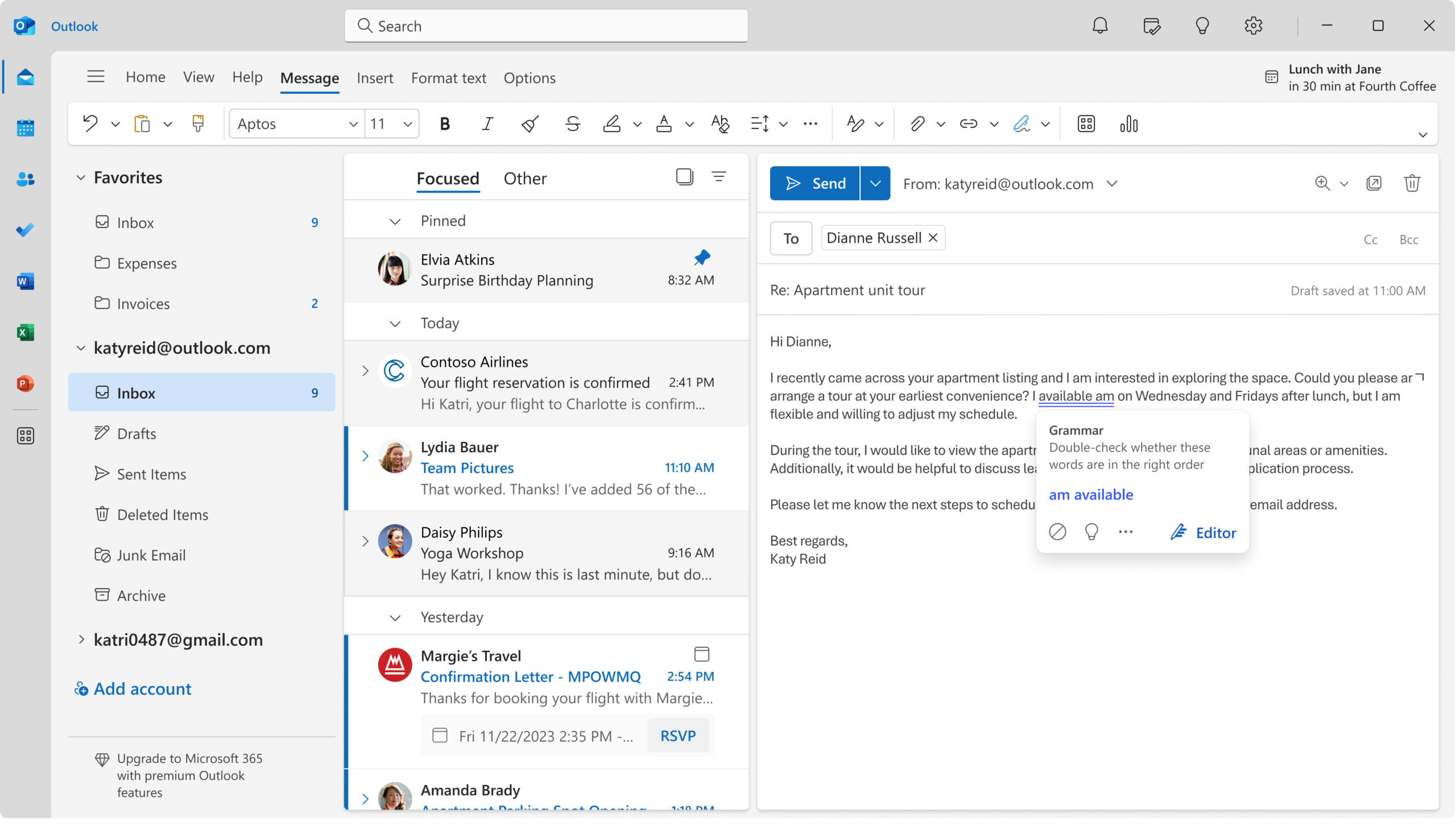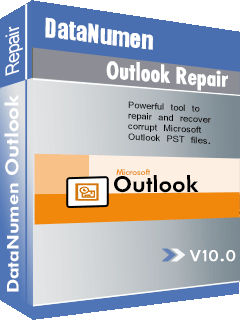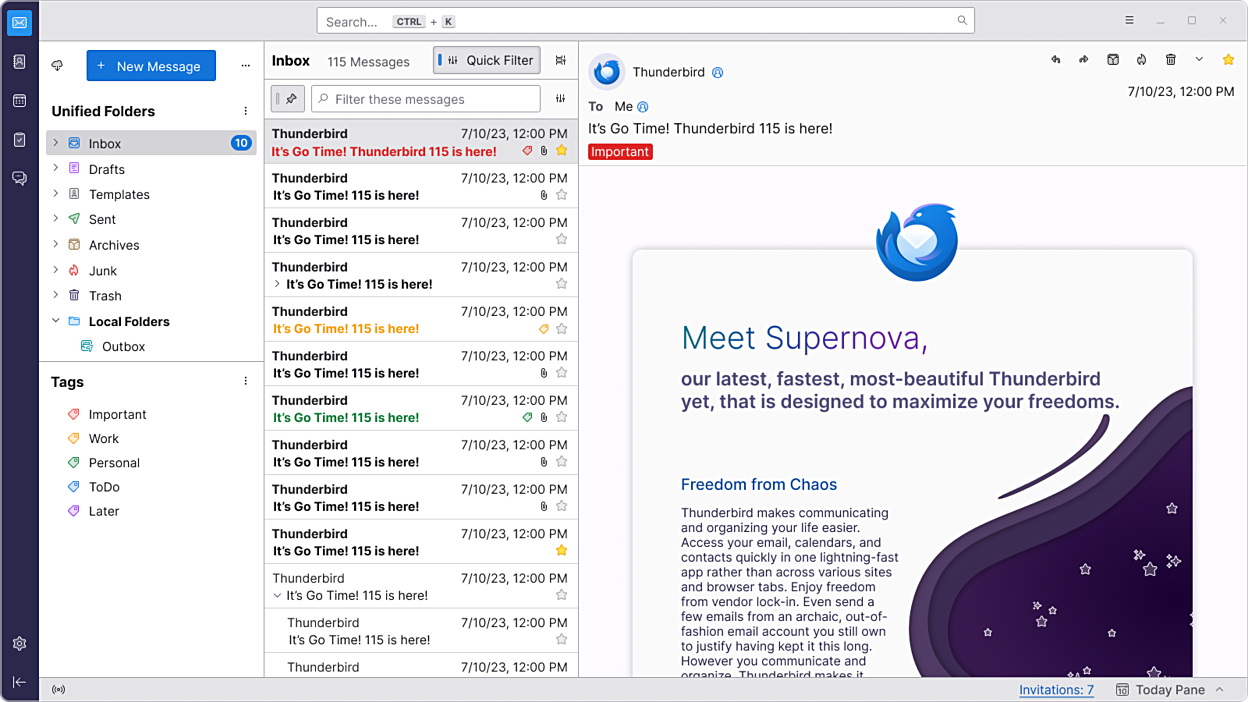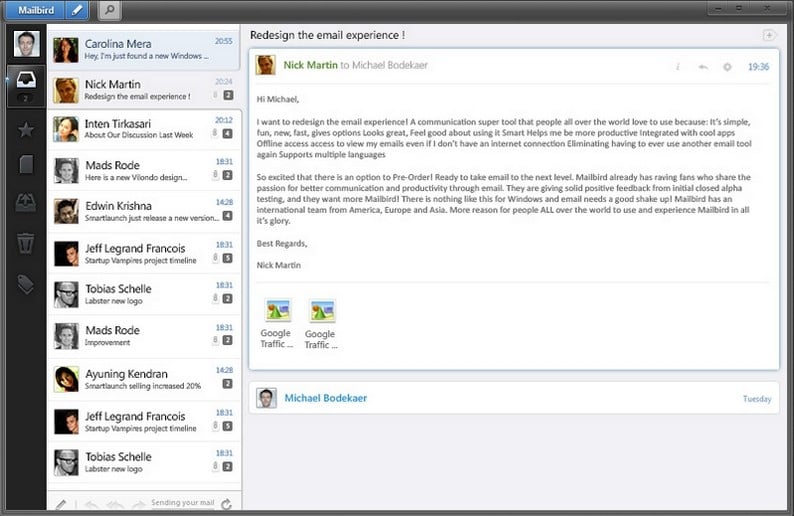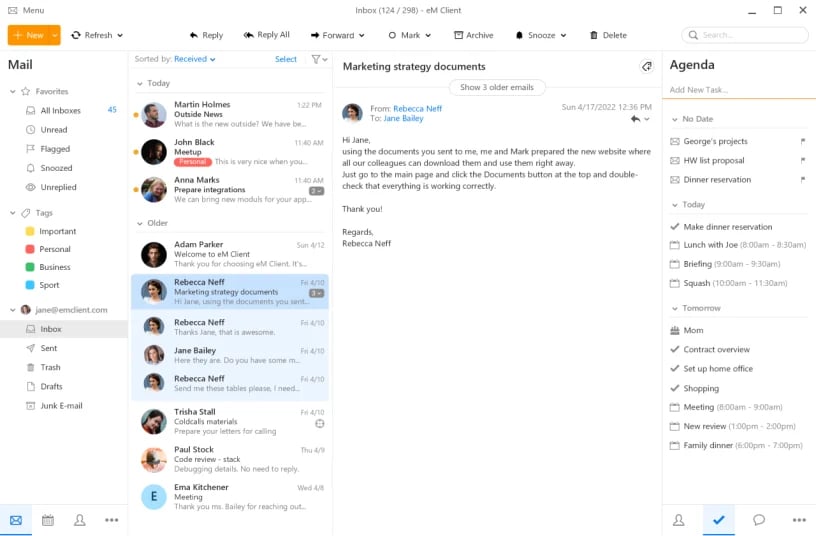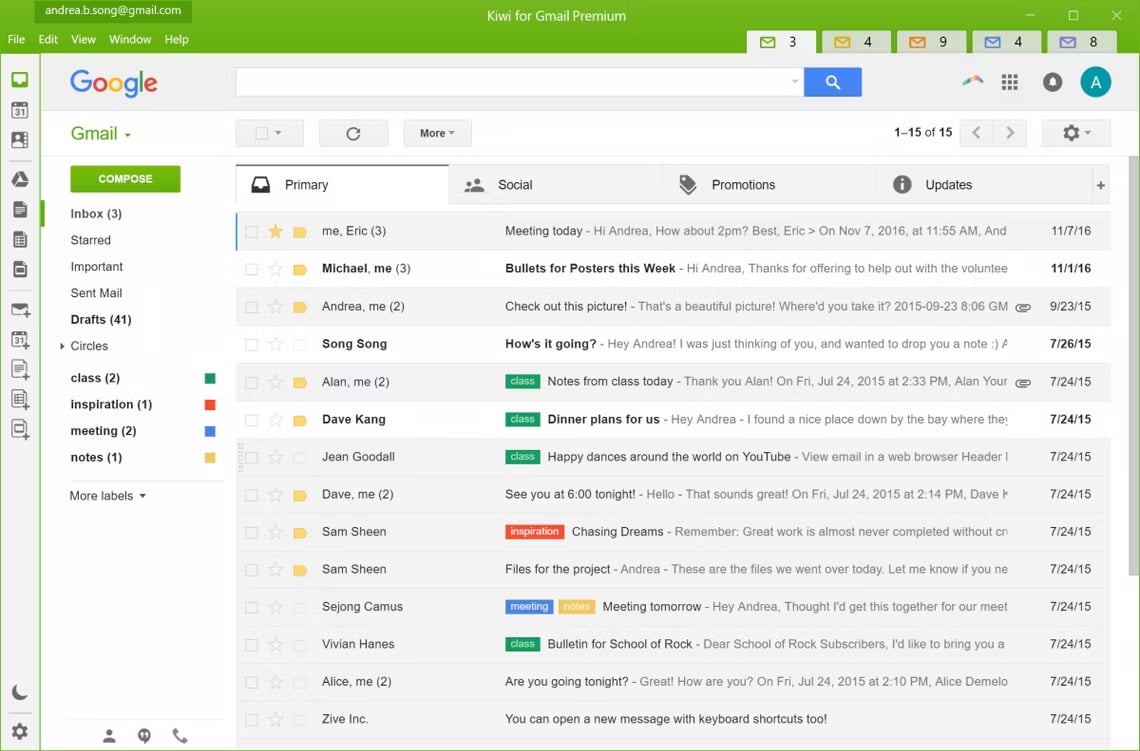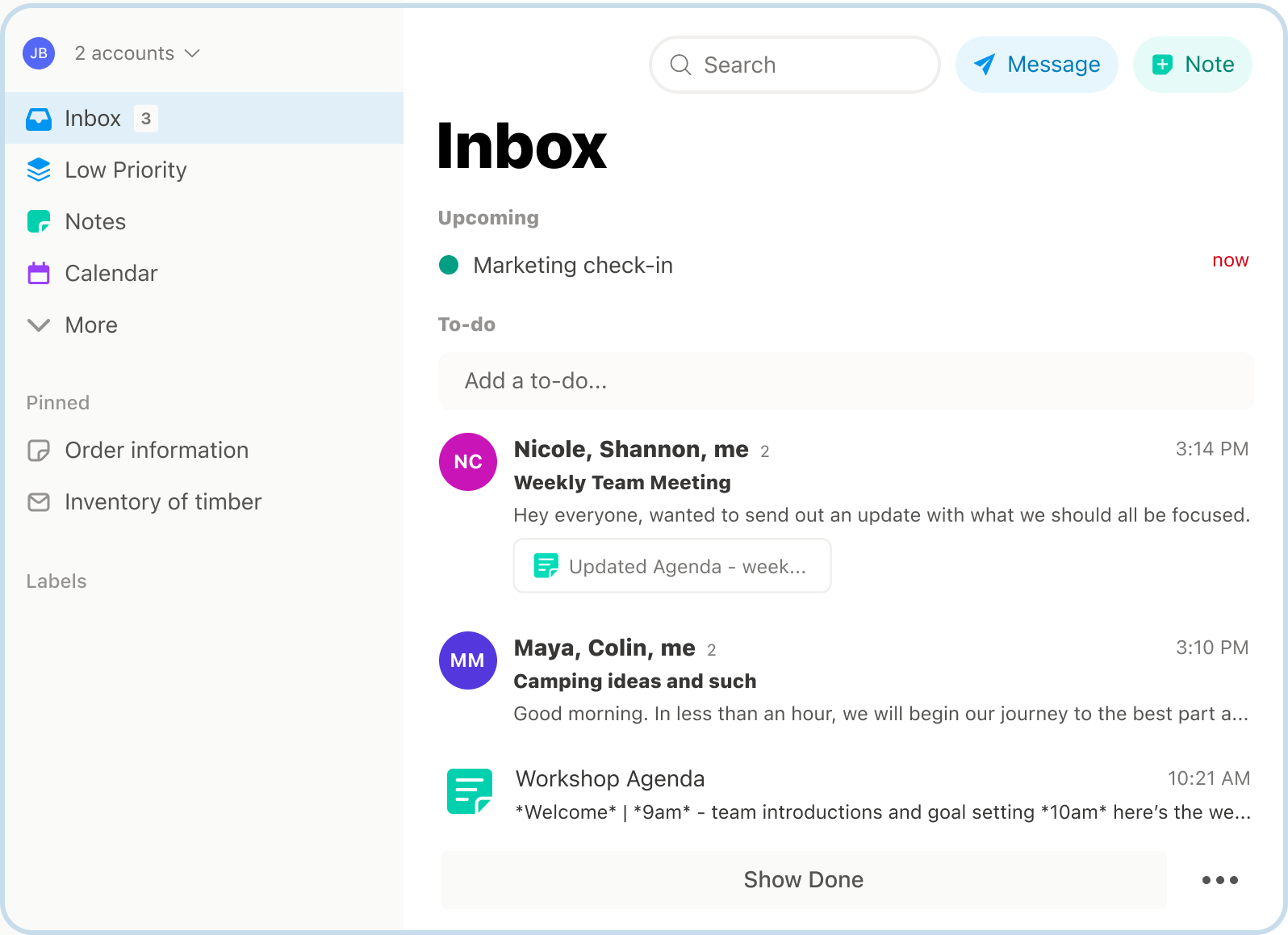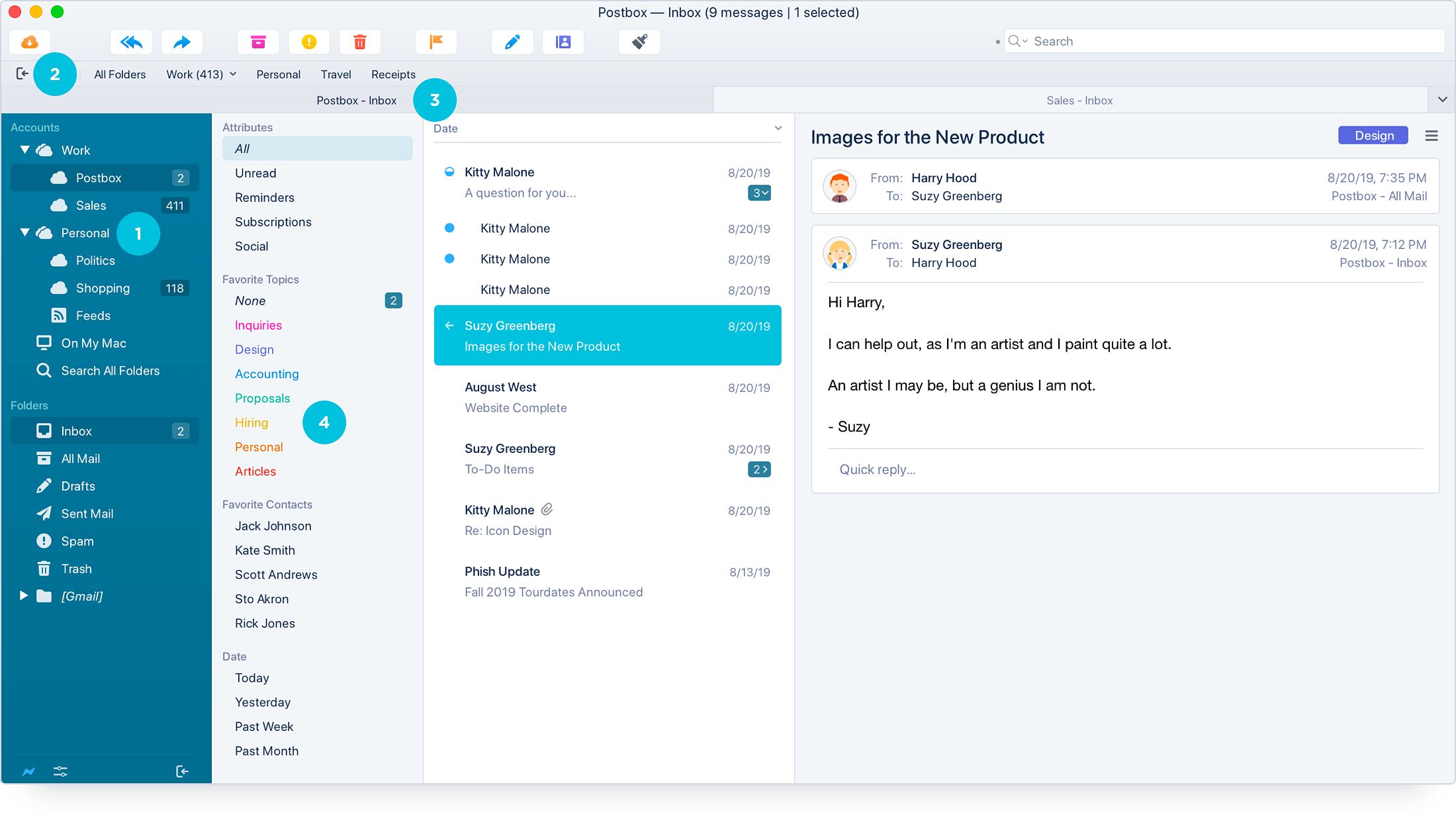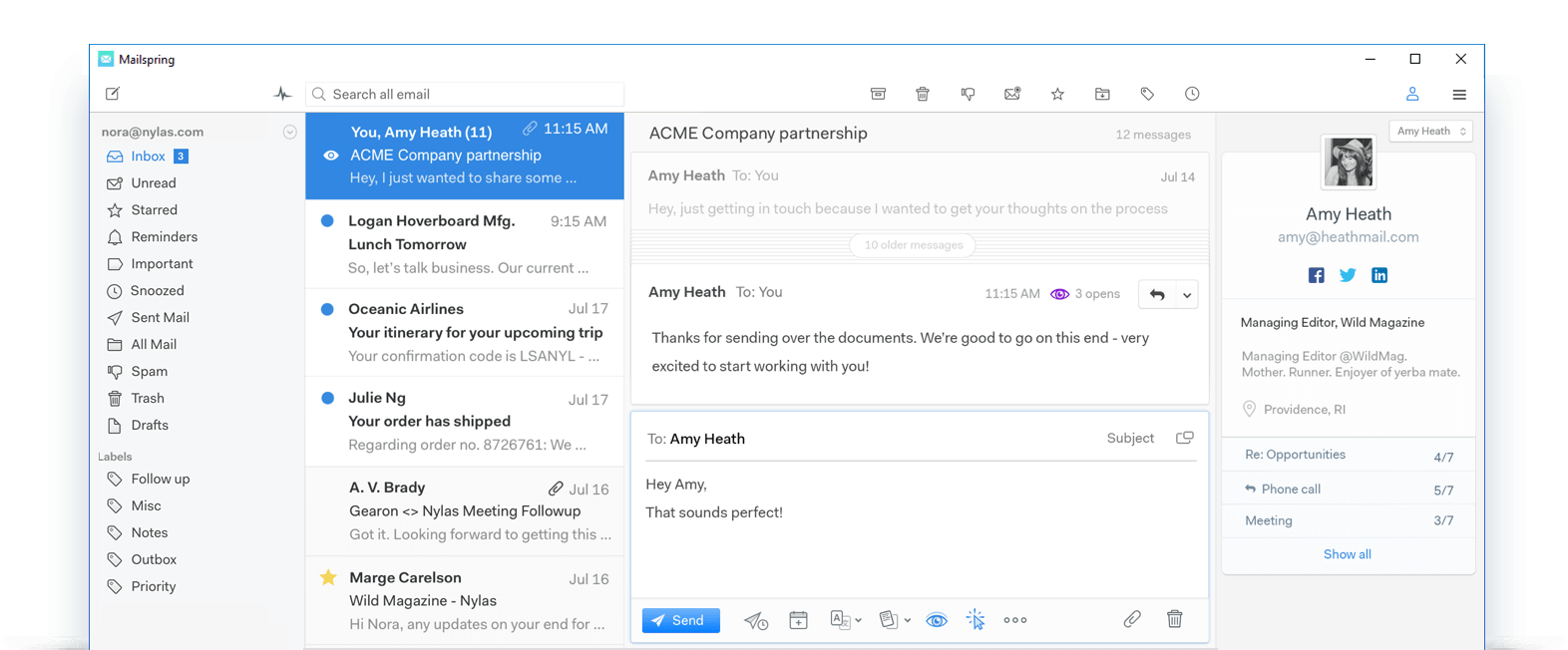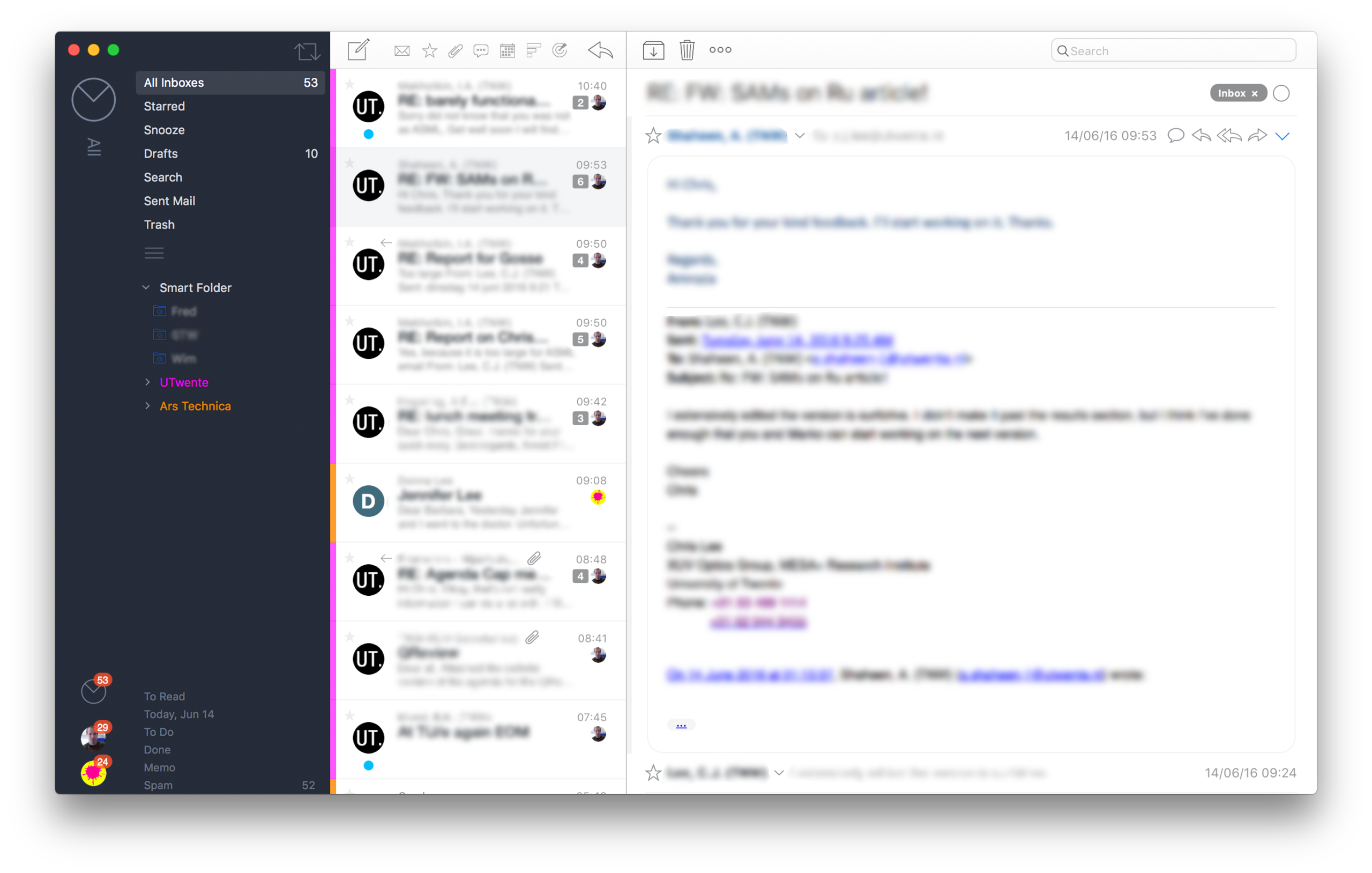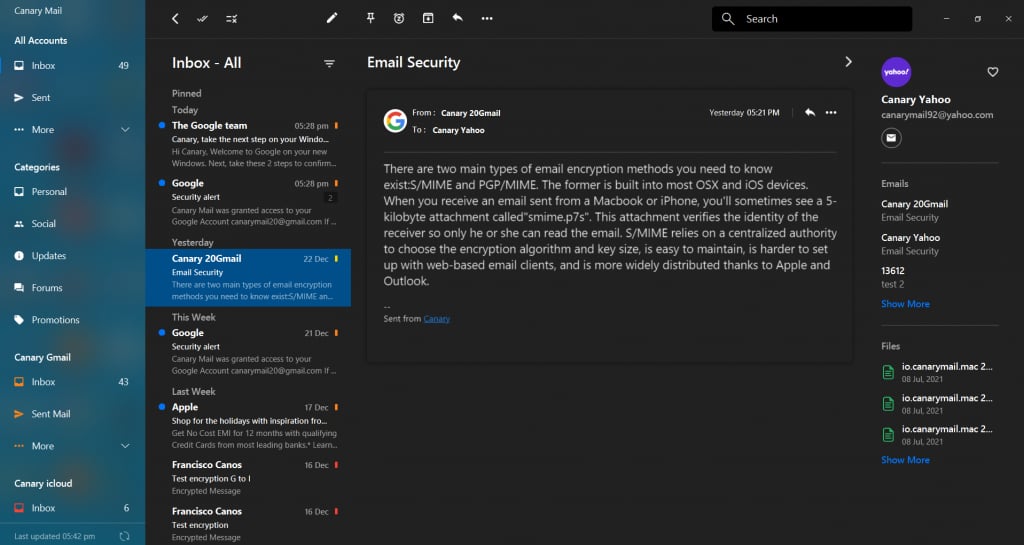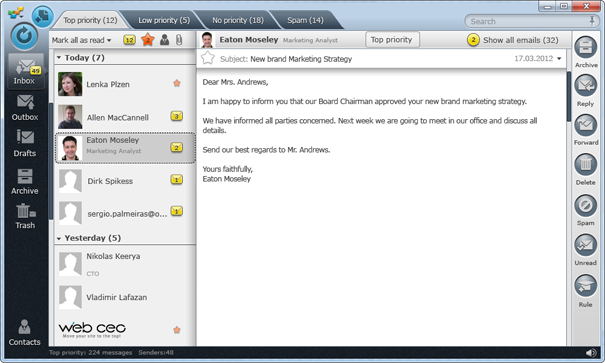1. Introduction
In today’s increasingly digital world, email has become a critical form of communication. Working professionals, students, and everyday individuals use email every day to stay connected, accomplish tasks, and more.
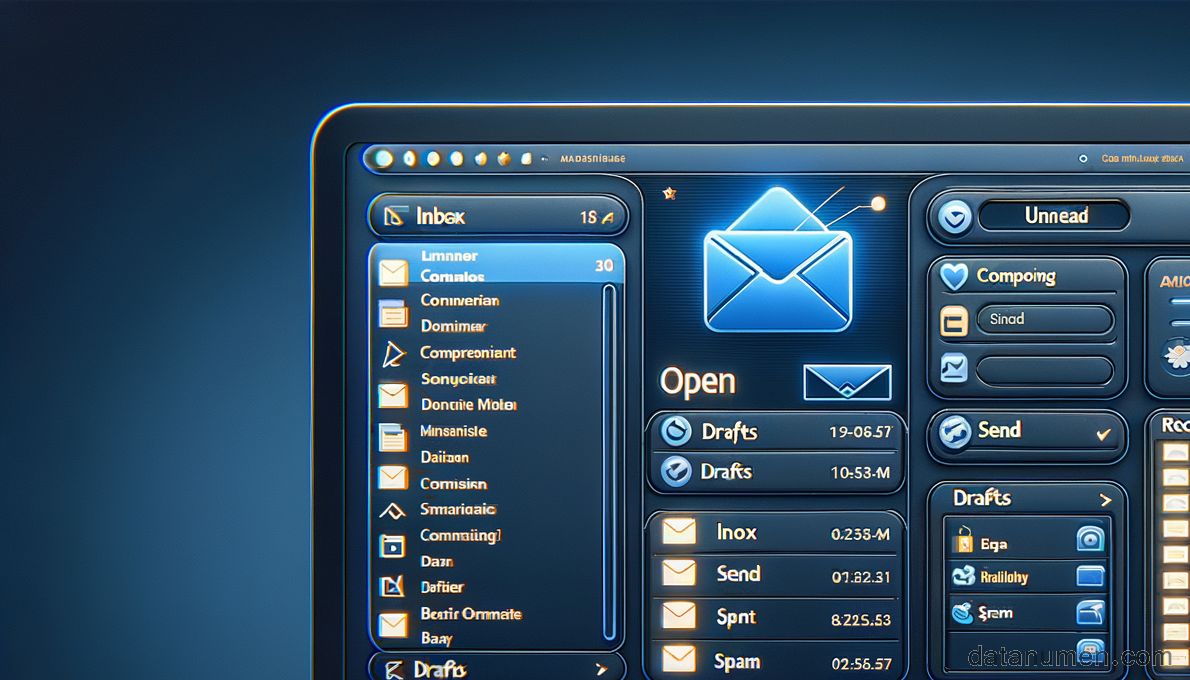
1.1 Importance of Email Client
An email client plays an essential role in this process, serving as the interface through which we interact with our emails. Email clients offer features like sorting and categorization, advanced search, spam management, and integration with other apps. They ensure that managing and navigating through thousands of emails becomes a streamlined and efficient task, rather than a monumentally overwhelming one.
1.2 Objectives of this Comparison
The purpose of this comparison is to examine different email clients in detail, identifying their strengths and drawbacks. With a plethora of email clients available in the market, it can be difficult for individuals and organizations to choose the one that best meets their needs. This comparison aims to offer clarity and guidance, aiding in the decision-making process by presenting detailed information about some of the top email clients available. The email clients have been selected based on factors such as popularity, general user feedback, and breadth of features.
2. Microsoft Outlook
Microsoft Outlook is a part of the Microsoft Office Suite, offering robust email management, scheduling, and communication capabilities. Featuring extensive integration with other Microsoft products, Outlook is a choice of many businesses worldwide.
Outlook provides advanced email organization, search, and communication tools. It integrates seamlessly with many other applications, including those within the Microsoft Office Suite, enhancing productivity and efficiency. Furthermore, it offers calendar features, task management, contacts organization, and note-taking capabilities, all under one application.
2.1 Pros
- Integration with Microsoft Suite: Outlook smoothly integrates with all Microsoft Office programs including Word, Excel, and PowerPoint, making it convenient for users to access and work with their documents directly from the email client.
- Advanced features: With tools like scheduled deliveries, follow-up reminders, and smart folders, Outlook makes it easier to streamline and manage email tasks effectively.
- Strong security: Outlook has robust built-in security measures including spam filtering, phishing protection, and encryption capabilities.
2.2 Cons
- Complex Interface: The user interface (UI) of Outlook is often seen as complicated and not very intuitive, especially for beginners.
- Cost: Outlook is a part of the Microsoft Office Suite, so it is more expensive compared to some other email clients that offer free versions.
- Performance Issues: Users have reported performance issues with Outlook, such as slow loading times and frequent crashing, especially when managing a high volume of emails.
2.3 Outlook PST Repair Tool
An effective Outlook PST repair tool is a must-have to all Outlook users. DataNumen Outlook Repair is a good choice:
3. Mozilla Thunderbird
Mozilla Thunderbird, developed by the creators of Firefox, is an open-source, cross-platform email client that includes smart folders, powerful search options and spam protections, making it a popular choice amongst individual users and small businesses.
Thunderbird has a customizable and user-intuitive interface, supports pop-up notifications, automatic spam mail filtering, and RSS news feed. It provides an integrated chat to connect to IRC, XMPP, Google Talk, and others. It also supports add-ons to provide additional features and improve your emailing experience.
3.1 Pros
- Free and Open Source: Thunderbird is a free, open-source client that values privacy and user control, allowing users to modify, customize and extend its capabilities.
- Integrated Chat: Thunderbird allows you to chat with others without having to open another application. It supports networks like Google Talk, IRC, and XMPP.
- Add-ons: Thunderbird supports numerous add-ons to improve its functionality, usability, and appearance.
3.2 Cons
- Limited Support: As an open-source platform, Thunderbird relies on community support for troubleshooting and assistance, which can result in slower response times when you encounter issues.
- No Integrated Calendar: Initially, Thunderbird does not come with integrated calendar functionality, although it can be added later through an add-on.
- Less Frequent Updates: The open-source nature of Thunderbird can lead to comparatively less frequent updates and feature releases than proprietary email clients.
4. Mailbird
Mailbird is an intuitive, feature-rich email client that is designed for Windows. It is admired for its clean interface and the unification of multiple communication platforms within one application.
Mailbird stands out for its simplicity and customization capabilities. It supports multiple accounts and offers an integrated suite of apps, including Facebook, Twitter, WhatsApp, Dropbox, and Google Calendar, amongst others. This allows users to manage their emails, messaging apps, task management apps, calendar apps, and more, all from one place.
4.1 Pros
- Multitasking efficiency: Mailbird allows you to manage multiple accounts and integrate numerous communication and productivity apps into one unified interface.
- Personalization: It provides a wide array of customization options including themes, layout settings, and more.
- User-friendly interface: It offers a clean and intuitive interface that is easy to navigate, even for non-tech savvy users.
4.2 Cons
- Windows only: Mailbird is only available for Windows users, restricting MacOS, Linux, or mobile device users.
- No free version: Even though it offers a trial version, there is no completely free version of Mailbird.
- Limited searching: Mailbird’s search functionality can sometimes be lacking, especially when dealing with large volumes of emails.
5. eM Client
eM Client is a comprehensive email client that is known for its advanced features such as integrated chat, advanced search and categorization, and also backup and restore capabilities.
eM Client goes beyond just email management, offering integrated chat, contact management, calendar synchronization, tasks, and notes. It supports all major services including Gmail, Exchange, iCloud, and Outlook. It also offers a unique sidebar providing communication history, attachment history, and agenda for easy organization and navigation.
5.1 Pros
- Integrated Chat: The client includes live chat for easy communication without relying on external chat applications.
- Unique Sidebar: eM Client’s sidebar provides a bird’s eye view of the communication history, future agenda, and attachment history, offering enhanced efficiency.
- Flexible Support: eM Client supports major email services, providing broad functionality for different users.
5.2 Cons
- Free Version Limitation: The free edition of eM Client only supports two email accounts, limiting its usability for users with multiple email accounts.
- No Push Notifications: eM Client lacks push notifications, which can slow down the receipt of new email notifications.
- Performance: With multiple features and capabilities, eM Client can be heavy on system resources, potentially causing lag on low-end systems.
6. Kiwi for Gmail
Kiwi for Gmail is a dedicated desktop client for Gmail users. It focuses on integrating the seamless functionalities of Gmail and G Suite to the desktop experience.
Kiwi for Gmail allows users to experience Gmail & G Suite apps, such as Google Docs, Sheets, and Slides, in a more efficient and feature-rich environment. It encapsulates all functions of Gmail and extends support for other Google services such as Google Docs, Sheets and Drive.
6.1 Pros
- G Suite Integration: Kiwi for Gmail seamlessly integrates with all major G Suite applications providing a unified platform for Google users.
- Multitasking: It allows users to open multiple accounts or documents in different windows simultaneously, improving productivity.
- Intuitive Interface: It reproduces the familiar Gmail interface in a standalone desktop client, making it easier for users to adapt.
6.2 Cons
- Limited Support: Kiwi is specifically designed for Gmail and G Suite, therefore lacks support for other email services.
- No Free Version: Unlike many other desktop clients, Kiwi for Gmail doesn’t have a free version available.
- Windows and Mac-Only: Kiwi for Gmail is not available for Linux or mobile platforms.
7. Twobird
Twobird is a minimalistic, all-in-one workspace designed around your inbox. It’s a product by Notion, known for its notes app with the same name.
Twobird aims to simplify your mailbox by merging your emails, notes, reminders, and calendar into a single application. It integrates directly with your Gmail account and provides an uncluttered environment to focus on your most important tasks.
7.1 Pros
- All-in-one Workspace: Twobird simplifies the user’s workflow by fusing notes, reminders, and email into a single application.
- Tidy-Up Feature: The ‘Tidy Up’ feature allows users to unsubscribe from and archive newsletters in bulk, maintaining a clean inbox.
- Minimalistic design: Twobird has a straightforward and clean interface that reduces visual clutter and makes navigation easy.
7.2 Cons
- Gmail-Only: At present, Twobird only supports Gmail and Google Workspace accounts.
- No Advanced Features: Unlike some other email clients, Twobird lacks some advanced features like complicated filtering and rules automation.
- No Unified Inbox: If you are using multiple Gmail accounts, you’ll need to switch accounts to view each inbox separately.
8. Postbox
Postbox is a powerful, feature-rich email client that effectively organizes and streamlines your workflow.
With its robust search, impressive filing system, and efficient keyboard shortcuts, Postbox helps users manage their emails swiftly and effortlessly. Postbox is compatible with Mac and Windows, and it works with any IMAP or POP account, including Gmail and iCloud.
8.1 Pros
- Powerful Search: Postbox features an advanced search function with 20 different search operators, making it easier to locate emails.
- Conversation Views: Postbox shows related messages together in a timeline view, enabling users to follow email threads and conversations effectively.
- Efficient Organization: Its filing system allows for easy organization of emails and productivity features like keyboard shortcuts and quick reply functionalities enhance efficiency.
8.2 Cons
- No Free Version: Postbox does not offer a permanently free version. After the 30-day trial period, you must purchase the software.
- Limited Customizability: Compared to other email clients, the customization options in Postbox are less flexible.
- No Calendar Sync: Postbox does not feature its own calendar, which can be a downside for users seeking an all-in-one tool.
9. Mailspring
Mailspring is designed to be a fast and efficient, modern-looking email client for Windows, Mac and Linux. It features powerful searching and organizational tools.
Mailspring allows for unified inbox, multiple account support, and features like scheduled emails, snoozing, and advanced search capabilities. Furthermore, it includes an inbuilt spell check and translation, enhancing the entire email experience.
9.1 Pros
- Advanced Mail Features: Mailspring offers features such as scheduled emails and snoozing. It also supports link tracking and detailed contact profiles.
- Unified inbox: Mailspring’s unified inbox gathers all your emails in one place, simplifying email management.
- Open Source: The base version of Mailspring is open source, making it a good choice for those concerned with transparency and community support.
9.2 Cons
- Pro version for Full Features: Some advanced features such as ‘snooze’, ‘send later’, ‘track opens/link clicks’, and ‘mailbox insights’ are only available in the paid Pro version.
- No Calendar: Mailspring lacks an integrated calendar, forcing users to seek other applications for scheduling.
- Sign-up Required: To use Mailspring, even for the free version, one has to create a Mailspring account.
10. Airmail
Airmail is a lightning-fast email client for Mac and iOS, which supports a wide range of email services and offers a host of features focused on speed and efficiency.
Airmail is designed from the ground up to provide a consistent experience across devices and deliver a swift and responsive performance. It supports full touch-screen interface, multiple accounts, rich text editing, and an app integrations for a seamless workflow.
10.1 Pros
- Wide range of email services: Airmail supports a variety of email services like Gmail, Yahoo, iCloud, Microsoft Exchange, and more.
- Highly customizable interface: Airmail offers configurable menus, gestures, keyboard shortcuts and swipes, allowing users to tailor the email client to their personal needs.
- Quick reply feature: Airmail includes a helpful quick-reply feature that lets you fire off responses right from the notification.
10.2 Cons
- Paid application: Airmail requires a purchased subscription for use. It does not offer a free version.
- No built-in calendar: Airmail does not offer a built-in calendar functionality.
- Search function: The search function may sometimes lack accuracy when dealing with a large number of emails or trying to search complex queries.
11. Canary Mail
Canary Mail is a secure, robust email client that combines simplicity and advanced features, offering impressive email solutions for Mac and iOS users.
Canary Mail champions uncompromised security alongside a host of powerful, cutting-edge features. It provides end-to-end encryption, and supports all the major email providers. The intuitive and smart interface makes handling emails smooth while also including neat features like smart filters, bulk cleaner, and the ability to snooze emails.
11.1 Pros
- Powerful encryption: Canary Mail offers automatic end-to-end encryption to ensure your email content is always secure.
- Smart Notifications: The client offers smart notifications that you can tailor according to your preference, making your workflow efficient.
- Pleasant aesthetics: Canary Mail has an aesthetically appealing and user-friendly interface which enhances the user experience.
11.2 Cons
- Costly: Canary Mail is one of the pricier options in the market, with no free version available.
- Limited to Apple: Currently, Canary Mail is available only for Mac and iOS users.
- No Calendar Feature: It lacks an integrated calendar, a feature many users look for in an email client.
12. EmailTray
EmailTray is a lightweight email client designed to simplify email management and improve productivity.
EmailTray intelligently ranks emails based on users’ email behaviors, focusing on the important ones and helping to mitigate email overload. With support to multiple email accounts, it notifies users about important emails instantly while summarizing all less important correspondence.
12.1 Pros
- Smart Email Sorting: EmailTray’s algorithm automatically sorts incoming emails by importance, allowing you to focus on what matters most.
- Spam Control: Apart from the traditional spam filter of your email server, EmailTray analyses your contact list, message recipients and senders, and builds a whitelist of reliable senders, ensuring better spam protection.
- Simplicity: The email client’s interface is clean and simple, enhancing usability and offering ease of navigation.
12.2 Cons
- Limited Features: EmailTray may not provide some of the advanced features that other clients offer.
- Windows-only: This client is available only for Windows users, limiting its usage.
- No Integrated Calendar: Like many lightweight email clients, EmailTray also lacks an integrated calendar feature.
13. Summary
Now that we have individually analyzed a variety of email clients, it is helpful to consider them side-by-side for a comparative outlook. The following table lays out some key parameters for each email client we have discussed.
13.1 Overall Comparison Table
| Tool | Features | Ease of Use | Price | Customer Support |
|---|---|---|---|---|
| Microsoft Outlook | Rich feature set with tools like scheduled deliveries and smart folders | A more complex interface may deter some users | Paid as part of the Microsoft Office Suite | Extensive support through Microsoft |
| Mozilla Thunderbird | Integrates chat and supports add-ons | User-friendly layout and open source platform | Free | Community support |
| Mailbird | Supports multi-accounts and app integration | Easy to use due to clean and intuitive interface | Paid with a free trial | Help center and community forum available |
| eM Client | Integrated chat and unique sidebar for easy organization | Straightforward interface makes it easy to navigate | Free version available, Paid version for more features | Supports via email or online form |
| Kiwi for Gmail | Excellent G Suite integration and multiple window support | Familiar Gmail interface | Paid with a free trial | Support offered through online forums |
| Twobird | Combines email, notes, and reminders in one place | Straightforward and clean interface | Free | Guides and FAQs available for support |
| Postbox | Advanced search function and efficient organization tools | Interface designed for ease of navigation | Paid with a free trial | Help center and support page available |
| Mailspring | Offers advanced features such as email tracking and scheduled emails | Simple to use interface in both free and paid version | Free and Paid versions available | Support available through online documentation |
| Airmail | Provides quick reply and smart notifications | Easy to use with a clean and intuitive interface | Paid with a free trial | Help center and FAQs available for support |
| Canary Mail | Powerful encryption and smart notification features | User-friendly interface and easy navigation | Paid | Support via email |
| EmailTray | Smart email sorting and spam control | User-friendly with a simple interface | Free | FAQs and online documentation for support |
13.2 Recommended Tool Based on Various Needs
Each individual or business will have unique needs and preferences when it comes to email management, and as seen above, each client has its own distinct set of advantages. Therefore, the decision should be made based on your specific requirements. It is recommended to always analyze the features, support, pricing, and ease-of-use before settling on any email client.
14. Conclusion
While all the email clients discussed in this guide have unique features and strengths, ultimately the best choice for you would depend on your specific needs and preferences.
14.1 Final Thoughts and Takeaways for Choosing an Email Client
When choosing an email client, consider factors such as the supported platforms, ease of use, compatibility with your main email account, and integration with other apps. If your day-to-day work involves dealing with a large number of emails or managing multiple email accounts, select an email client that is feature-rich and allows for easy email organization and management.
If you value security and privacy, look for email clients that offer encryption, spam control, and alert features. Assess the need for additional functionalities, such as calendars, tasks, and notes. The cost could play a significant role too, with options ranging from free open-source email clients to paid ones with premium features.
Bear in mind that most email clients offer trial versions, so it’s a good idea to test out a few before settling on one. By carefully considering these factors, you can find an email client that best meets your needs and enhances your productivity.
Author Introduction:
Vera Chen is a data recovery expert in DataNumen, which provides a wide range of products, including an advanced SQL recovery tool.
